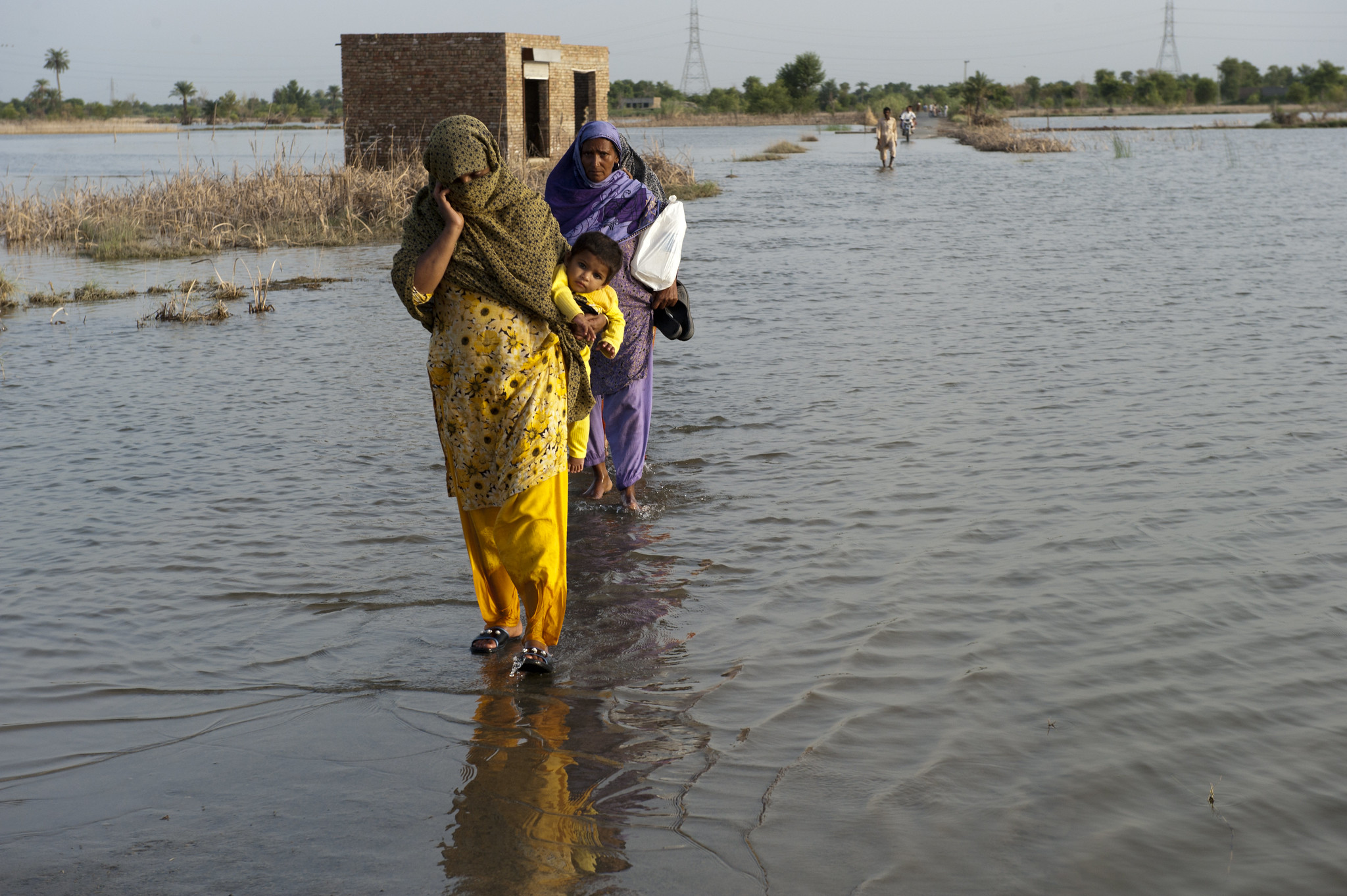Climate Justice and Loss and Damage in the Pakistan Flood Crisis
What obligations do wealthier nations—whose economies have historically emitted the bulk of greenhouse gas emissions—owe to nations like Pakistan that emit little but suffer the worst climate impacts?

Published by The Lawfare Institute
in Cooperation With

Science fiction author William Gibson is often credited with writing, “The future is already here. It’s just not evenly distributed yet.” For Pakistan and other nations in the Global South, a climate-destabilized future is not some faraway science fiction fantasy. Climate change impacts are here, with many people already living in a modern dystopia. Consider the torrential flooding in Pakistan, where a third of the nation is underwater. The Pakistani climate minister has called it a “crisis of unimaginable proportions” and the head of the United Nations has accurately labeled the flooding a “climate catastrophe.”
The impacts of climate change are not evenly distributed, and neither is the blame. Just three nations—the United States, China, and India—account for over half of carbon emissions.
Who should pay for Pakistan’s loss and damage? And what should be done to prevent and compensate for climatic harm disproportionately borne by developing nations?
Climate Change's Security Impacts
By some estimates, Pakistan’s crisis was entirely predictable. One year ago, the National Intelligence Estimate (NIE), a study from the U.S. Office of the Director of National Intelligence, issued an influential report that highlighted climate change’s security challenges around the globe. Pakistan, a nuclear nation, was identified as one of 11 “highly vulnerable countries of concern,” and the NIE identified flooding as a security risk in Pakistan. The Global Climate Risk Index, an annual independent study from Germanwatch, agrees with the NIE’s assessment, naming Pakistan the eighth most vulnerable nation to long-term climate risk.
These grim predictions are coming true. Today, Pakistani cities, villages, and massive swaths of farmland are underwater due to the heaviest rainfalls ever recorded in Pakistan’s history. Scientists link this torrential downpour to human-caused climate change. Over 1,000 people have died from massive flooding, and three quarters of a million people are left without access to safe and adequate housing. The flooding has already destroyed an estimated $10 billion of Pakistan’s economy. While the United States and other nations have pledged humanitarian assistance to Pakistan, these pledges are far short of what is needed.
The current crisis in Pakistan highlights a broader gap in international climate governance. Efforts to formalize funding from wealthier, developed nations to poorer, developing nations to address climate harm—what is known as “loss and damage”—have failed. But calls for loss and damage are growing louder. Pakistan’s environmental nightmare has broader implications for loss and damage that are poised to take center stage at the 2022 United Nations Climate Change Conference, known widely as COP 27, in Sharm el-Sheikh, Egypt, in November.
Loss and Damage: A Form of Climate Reparations?
The three legs of the climate stool now include mitigation, adaptation, and—most recently—loss and damage. Mitigation seeks to curb greenhouse gas (GHG) emissions. Adaptation seeks to take proactive measures to protect communities from climate change—think climate-resilient investment or even managed retreat from vulnerable climate areas. Loss and damage seeks to help people after they experience climate-related impacts. But all three legs of the stool are wobbling and veer toward collapse.
First, global mitigation efforts have fallen far short of what is needed to avert climate catastrophe. To have even a chance of meeting the Paris climate agreement’s most ambitious goals of keeping global temperatures below 1.5 degree Celsius, global “mitigation ambition” must accelerate. According to a 2019 climate report, overall global emissions must decrease by at least 7.6 percent per year by the end of this decade to avoid climate catastrophe. Despite the temporary drop-off in emissions due to the coronavirus pandemic, emissions are now rising. Without immediate transformational action, global temperatures are poised to blast through the Paris Agreement’s goals.
Second, climate adaptation efforts have also fallen short. Climate adaptation tools, namely the Green Climate Fund and the Adaptation Fund, have suffered from the “big hat, no cattle problem”—they’re all talk. Wealthier nations have promised to fund $100 billion per year in adaptation funding to developing nations. Yet the Organization for Economic Cooperation and Development estimated that just $79.8 billion in total had been provided in 2019, much of it in loans. The most recent Conference of the Parties met in Scotland in 2021 and produced the Glasgow Climate Pact. It acknowledges the shortfall between adaptation commitments and follow-through: “not[ing] with deep regret that the goal of developed country Parties to mobilize jointly USD 100 billion per year by 2020 ... has not yet been met.”
As mitigation and adaptation efforts have faltered, all eyes are on the third leg of the climate stool: loss and damage. Loss and damage begins where the limits to adaptation end. Dismissed by some as punitive “climate reparations,” loss and damage includes the adverse impacts of climate change that occur despite efforts to mitigate and adapt to climate change. Scholars have defined “loss” to encompass the irrevocable loss of human lives, culture, and biodiversity. This includes both economic and noneconomic components, such as the loss of cultural heritage. “Damage” refers to negative climate impacts where repair or restoration is still possible.
In a promising sign, the 2015 Paris Agreement breathed new life into loss and damage, identifying areas of possible cooperation. This includes emergency preparedness, slow-onset events, and community resilience: “Parties recognize the importance of averting, minimizing and addressing loss and damage associated with the adverse effects of climate change, including extreme weather events and slow onset events, and the role of sustainable development in reducing the risk of loss and damage.”
Developing nations in the Global South have continued to push the United States (the world’s largest historic emitter) and other developed nations to fund a loss and damage “facility” that would go beyond talk and produce commitments and processes to compensate nations for climatic harm. Nevertheless, wealthier nations are reluctant to accept climate liability and fund anything that may be perceived as climate reparations or admission of guilt for past GHG emissions.
The 2021 Glasgow Climate Pact fell short of establishing a loss and damage facility that could have helped streamline aid to Pakistan and other developing nations. Establishing a loss and damage facility could set in motion more concrete financial commitments to compensate for climate harm and streamline aid. Instead, Glasgow offered a loss and damage “dialogue” that sought to “minimize and address loss and damage associated with the adverse impacts of climate change.”
As the mitigation, adaptation, and loss and damage legs of the climate stool teeter toward collapse, weighty questions of climate justice arise. What obligations do wealthier nations—whose economies have historically emitted the bulk of GHG emissions—owe to poorer nations that emit little but suffer the worst climate impacts? Developing nations are increasingly discouraged from relying on fossil fuels to develop their economies and reap the economic rewards enjoyed by the Global North. Pakistan, for example, emits less than 1 percent of the world’s GHG emissions yet suffers massive climate impacts. So, too, does the Sahel, which emits miniscule emissions yet endures record-breaking droughts, food insecurity, and other climate impacts.
And small island nations act as the ultimate canary in the climate coal mine: climate-driven sea level rise and flooding are poised to extinguish entire nations by mid-century, raising the specter of statelessness. Yet international law fails to protect climate refugees and has not wrestled with climate-driven nation extinction. While the U.N. General Assembly just made the historic declaration that there is an affirmative human right to a clean, healthy, and sustainable environment, it remains unclear how this will be implemented and enforced.
Pakistani Flooding: Spurring Loss and Damage in Egypt?
Despite promising to alleviate harm caused to the most vulnerable nations, the world’s largest carbon emitters have failed to embrace loss and damage efforts while simultaneously falling short on mitigation and adaptation efforts. And due in part to the fallout from Speaker of the House Nancy Pelosi’s, D-Calif., visit to Taiwan earlier this month, China and the United States—the two nations most responsible for climate catastrophe—are not even talking about climate solutions.
The failure to fund a loss and damage mechanism has been aptly described as a “gaping hole” in the climate change international legal governance structure. As the climate negotiators prepare for COP27 in Egypt later this fall, the images of Pakistan’s massive human suffering will be prominent in everyone’s minds. And Pakistan is chairing the main alliance of developing nations in Egypt. The tragedy unfolding in Pakistan provides Exhibit A that serious consideration must be made to fund and resource a loss and damage mechanism. Reactive, ad hoc commitments are not enough, particularly as climate impacts are felt throughout the Global South.
For Pakistan, many African nations, and several small island developing states, the climate-destabilized future is already here. Will the world listen and prevent a rickety climate stool from imminent collapse?



.jpg?sfvrsn=5a43131e_9)

